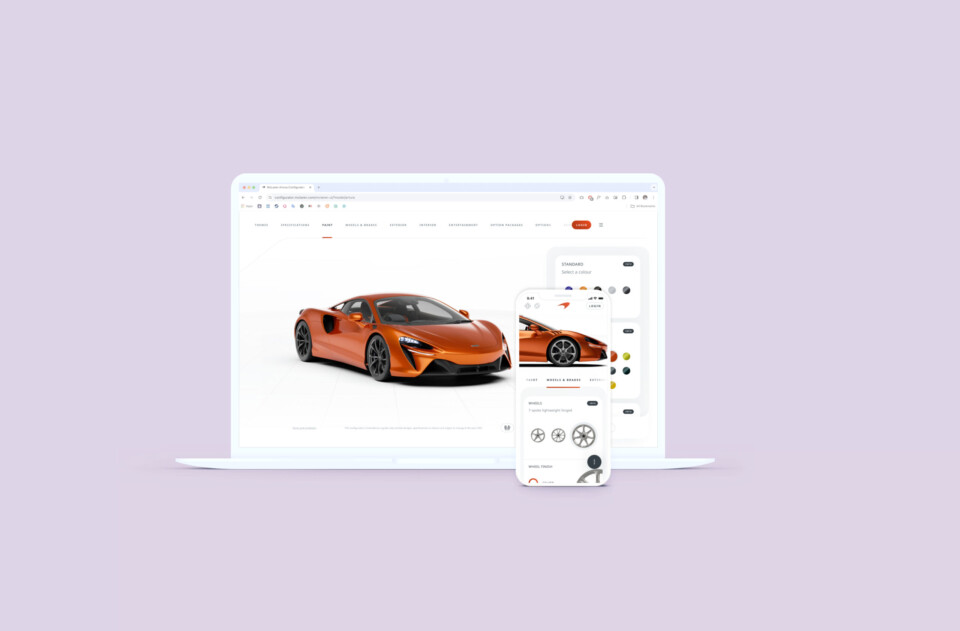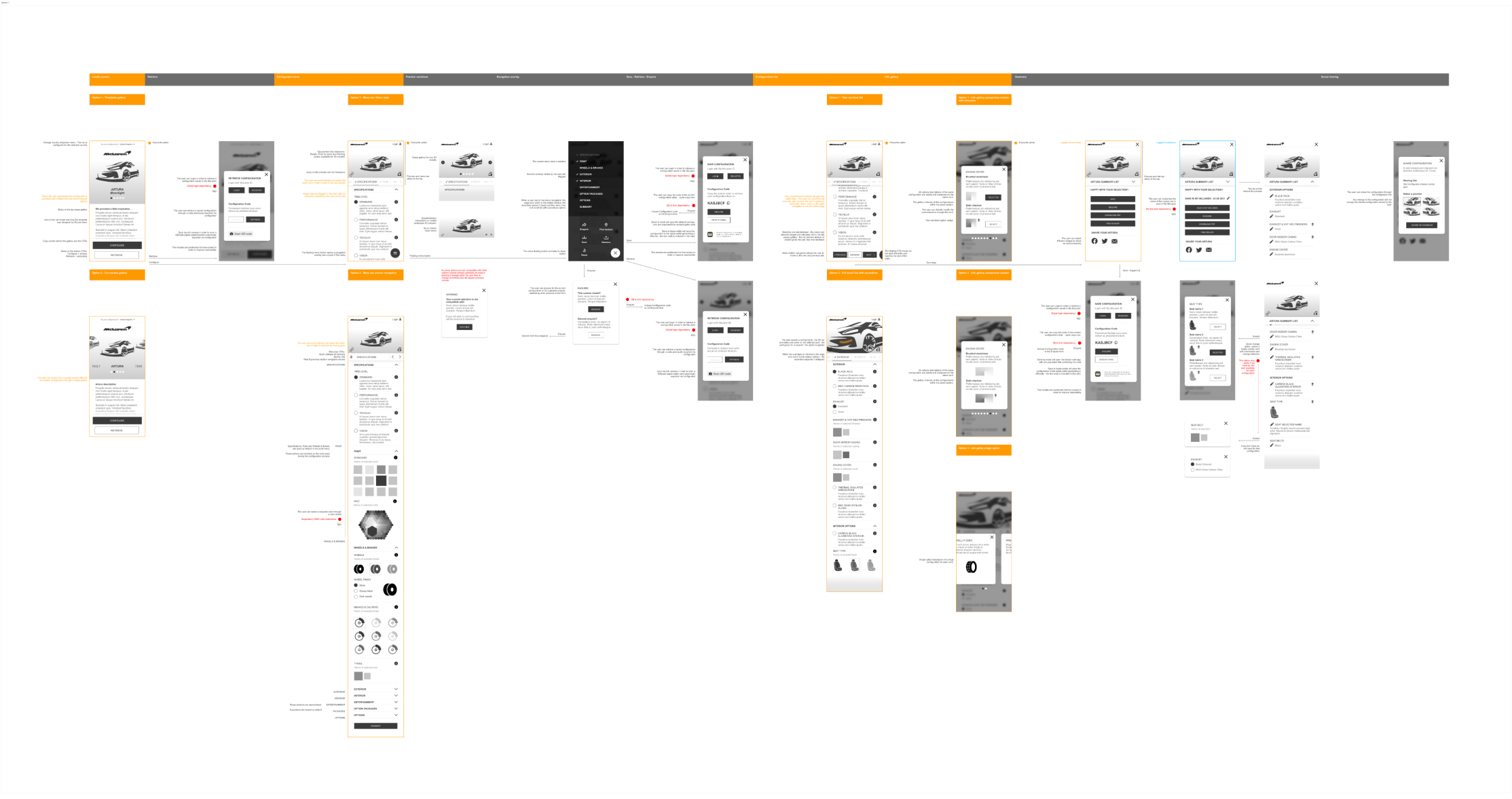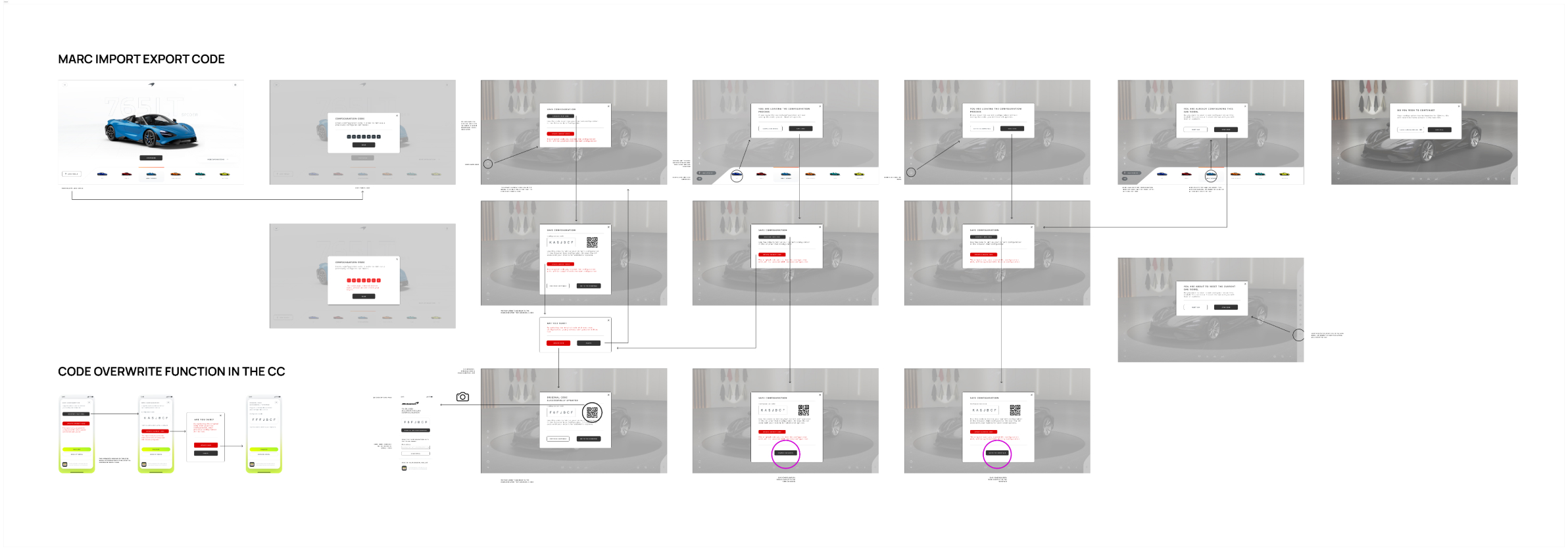McLaren – Car Configurator
Car Configurator
McLaren Automotive
Executive summary
The project aimed to improve the user experience of the McLaren car configurator for potential customers. The objectives included updating features, optimizing for mobile, and improving and monitoring performance. The scope involved reviewing, designing, testing, and refining the new configurator with a user-centric approach.
Following the redesign, configuration completion rates increased by 30%, driven by enhanced usability, seamless integration between the web configurator and in-store MARC systems, and mobile optimisations.
My role
Defining goals and KPIs, Research, Wireframing, Validating & Testing
Timeframe: 4 weeks (Before handoff to development)
Background
McLaren, a British automaker renowned for its emphasis on creating powerful and high-speed sports cars and supercars, offers a diverse range of vehicles designed for both street and track use. The lineup of supercars features models with a wide array of customization options, which can be explored through an online and in-store car configurator software.
The team
On the team at MediaMonks, I played a role as a UX designer and researcher. My job involved shaping and carrying out the project plan. That meant laying out tasks, setting timelines, marking project milestones, and delivering both research and interaction designs.
Understanding the problem
We worked with McLaren to organize and run an affinity mapping workshop focused on identifying the key goals, limitations, and areas of improvement related to the car configurator. By collaborating with stakeholders from different departments, we gained valuable insights into the specific requirements and potential obstacles facing the project.

UX plan
A UX plan is essential in ensuring that the user experience design process is structured, organized, and informed by user needs and business goals. It outlines the various steps and activities involved in the design process, such as research, testing, and analysis, which helps to create a coherent and effective user experience.
- Goals and KPIs
- Competitive benchmark and heuristic evaluation
- Research objectives
- Semi-structured interviews
- Informative user testing
- Wireframing and documentation
Competitive analysis
In the evaluation of the McLaren Car configurator and its competitors, a thorough analysis was conducted. Four car competitors (Porsche, Aston Martin, Tesla, BMW), two non-car related configurators (Bentley, Honda Motorbikes, and Nike) were reviewed. This approach not only highlighted strengths and weaknesses in competing designs but also explored solutions from secondary product categories. The evaluation offers a high-level view of the competitive landscape, pointing out areas for potential improvement in the McLaren Car configurator.
Browse the competitive benchmark below, alternatively use the following link: CC Competitive Benchmark
Detailed report: Table of Opportunities
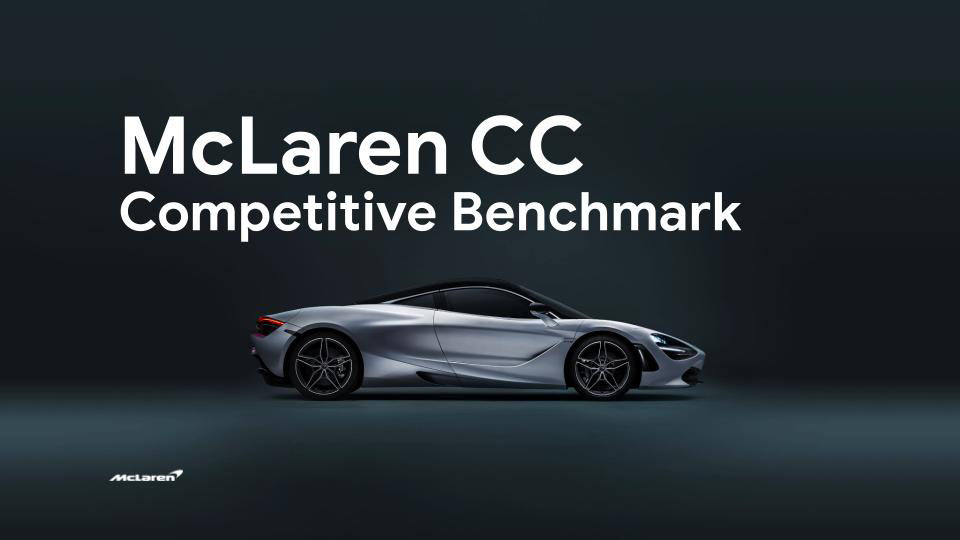
Heuristic evaluation
In our heuristic evaluation of the configurator, we identified significant problems related to navigation, information architecture, guidance, sharing, and accessibility. We employed a severity scale to rank and prioritize these issues, developing mitigation plans for each friction point.
Browse the heuristic evaluation below, alternatively use the following link: CC Heuristic Evaluation
Detailed report with friction points and mitigations: Table of Opportunities
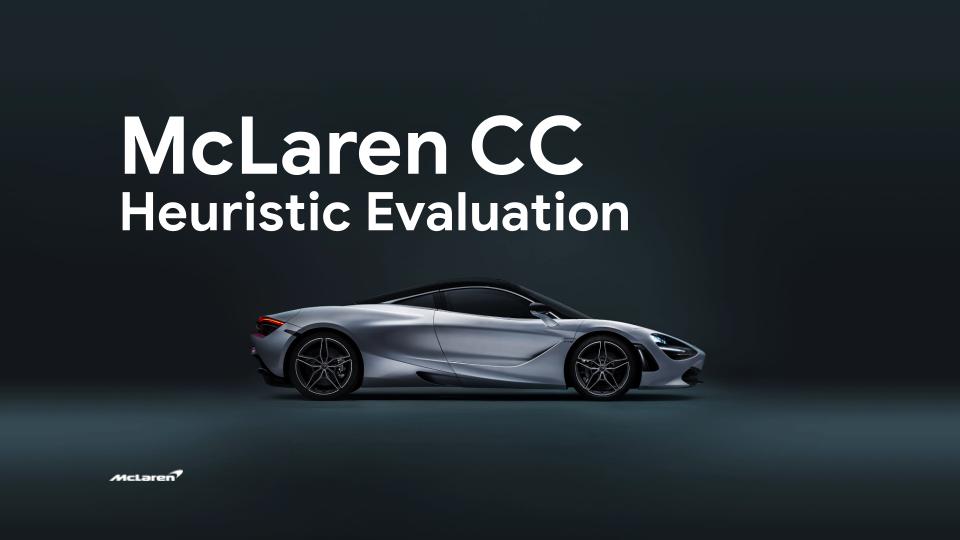
Key research objectives
Clear research objectives are essential in UX research as they guide the research plan and methodology. They also help stakeholders understand the value of UX research in developing user-centered products and services.
- Validate value proposition
- Mobile usability
- Context of use
- User goals vs outcomes
- Brand recognition
- Social sharing
Semi-structured interviews
To validate desk research findings, we conducted dealer interviews and user research with a sample size of 5 participants. Dealer interviews aimed to understand customer actions post-configuration, identify complaints, determine popular customizations, and assess how the configurator aids dealer-customer collaboration. The semi-structured interviews provided insights beyond the key objectives, offering a more comprehensive understanding of the subject matter.
Browse the interview discussion guide at the following link: Dealer discussion guide
User testing
In the final phase of our research, we conducted an unmoderated user testing evaluation of the Car Configurator. The objectives were:
- Evaluate user navigation issues.
- Determine preferences between linear nav. and pick & choose.
- Assess preferences for a guided experience.
- Explore mobile user experience with device rotation.
- Identify the most used configurations.
- Evaluate the availability of help and information.
Sampling ten participants from McLaren’s customer demographic (five on mobile, five on desktop), the user testing uncovered opportunities for usability improvements, insights into enhancing brand perception, and highlighted well-received features of the car configurator.
Browse the user testing script here: User Testing Script
Learning
After completing research triangulation, it is important to group all the findings and prioritize them based on the potential return on investment. One effective approach is to create a table of opportunities that identifies each finding and quotes the level of effort required for implementation. Then, each finding can be evaluated based on its potential return on investment, considering both immediate gains and long-term benefits.
Wireframing
Building on the research insights, we developed high-fidelity wireframes that mapped every possible configuration scenario, ensuring the experience felt intuitive across all user paths. We established flexible interaction patterns to accommodate future expansions and seamless integration between online and in-store systems, setting a solid foundation for the visual and functional design phases.
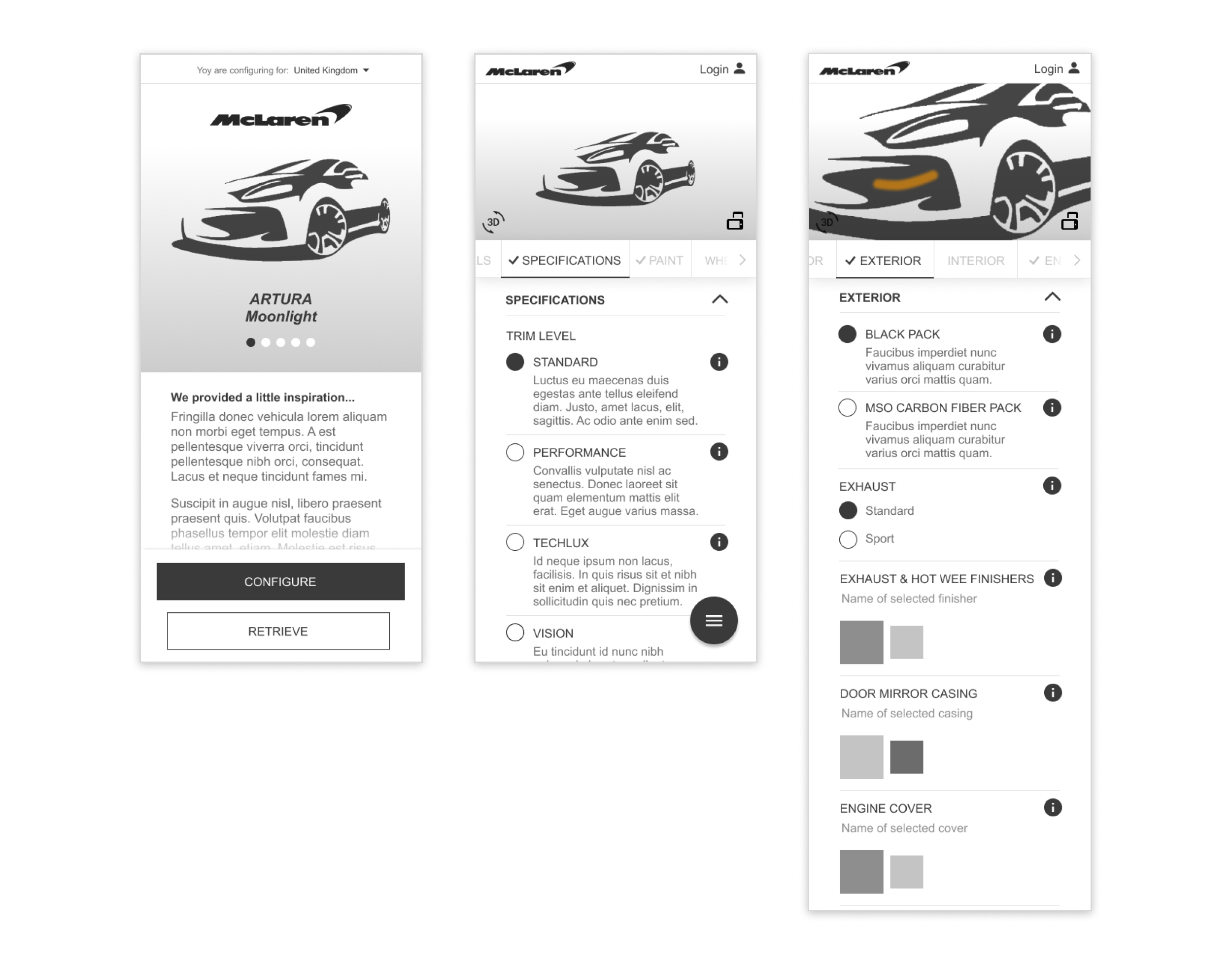
Project spinoff – Integration with MARC
In the McLaren showroom, customers could use the MARC, a unique car configurator offering a 3D experience on large HD touch monitors with the option to export short cinematics of configured cars. However, the MARC and the web-based Car Configurator in this project were not integrated, causing friction when customers wanted to seamlessly continue configurations between home and the showroom. This led to manual reentry of customisations by the retailer or customers.
The goal of the spinoff project was to enhance both software systems by enabling the saving and retrieval of configurations initiated from different sources, such as the web-based Car Configurator or the MARC.
Desk research
The initial phase involved mapping out the user journey across both the personal device environment and the showroom setting, introducing a new persona – the salesperson’s role.
Drawing insights from our prior semi-structured interviews conducted for the web Car Configurator, we crafted a comprehensive flow. This encompassed the primary persona, the customer, and the secondary persona, the salesperson, engaging with the MARC system in the McLaren showroom.
See the flow diagram below for a quick overview, alternatively open the Figma file: MARC integration flow.
Wireframing
To mitigate privacy issues during authentication on shared devices like MARC, we introduced a handover process to seamlessly transfer configurations between MARC and the web Car Configurator using unique codes. Both software systems were updated to generate, store, and share customizations through these codes.
This approach, adopted by competitors, serves as a streamlined solution to enhance the user journey from private device configuration to in-store devices.
See the wireframes below for a quick overview, alternatively open the Figma file: MARC integration.
Final thoughts
In closing, the McLaren Car Configurator project showcased how user-centric design can solve complex challenges and enhance brand connections. By addressing key pain points and optimising experiences, we delivered a solution that improved usability and reinforced McLaren’s digital presence, meeting both user and business goals.

